Project Management: Methods Analysis and Risk Assessment Report
VerifiedAdded on 2023/01/18
|13
|2273
|62
Report
AI Summary
This report delves into the core concepts of project management, offering a critical analysis of three prominent methodologies: Agile, Six Sigma, and PRINCE2. It explores the advantages and disadvantages of each method, providing a comparative perspective for practical application. The report further examines project management tools, including Gantt charts and network diagrams, to illustrate project scheduling and task dependencies. Additionally, it covers stakeholder analysis, categorizing stakeholders based on their influence and interest, and risk analysis, identifying and mitigating potential project risks related to cost, schedule, performance, market, and legal considerations. The report concludes by emphasizing the importance of these analytical tools in achieving successful project outcomes.
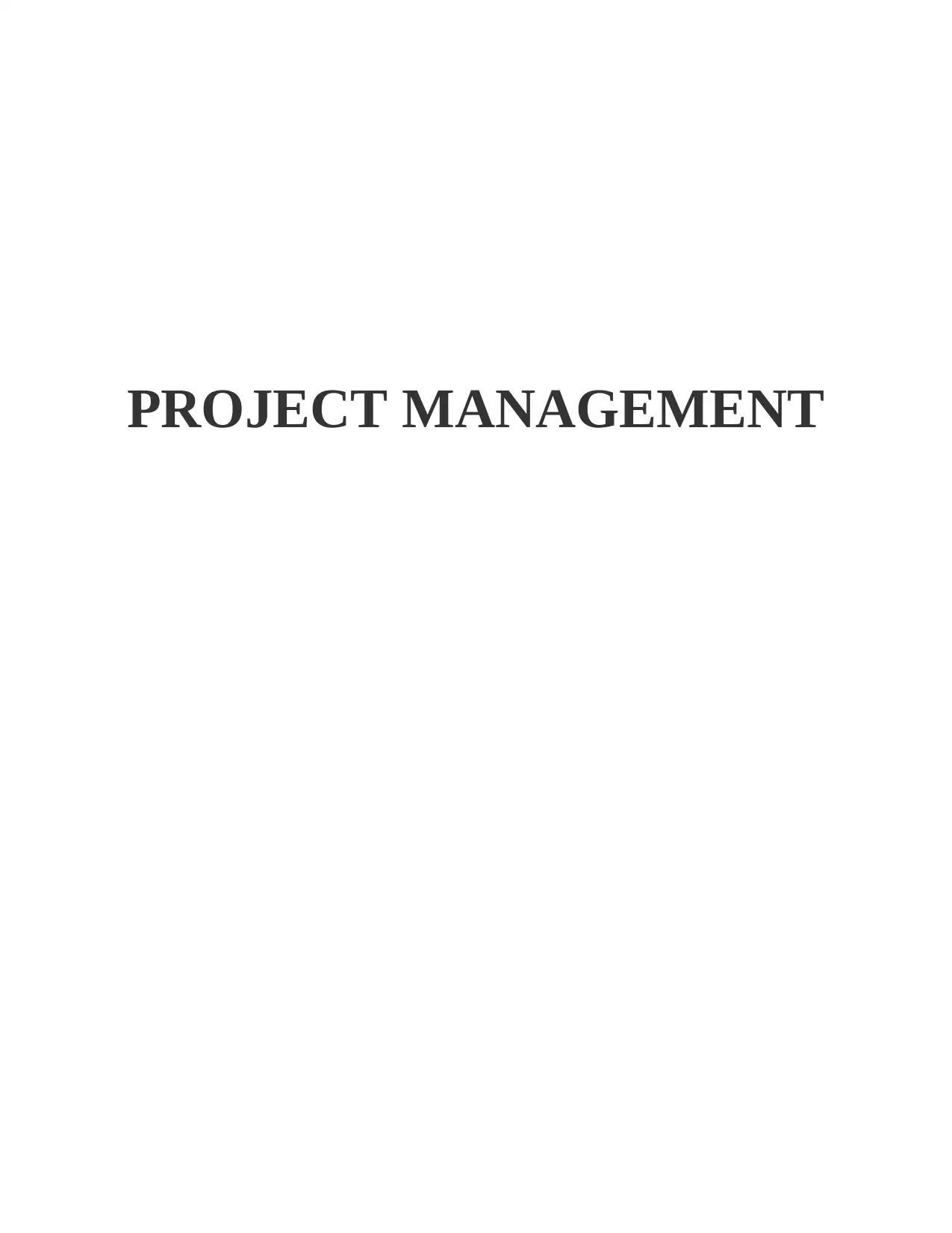
PROJECT MANAGEMENT
Paraphrase This Document
Need a fresh take? Get an instant paraphrase of this document with our AI Paraphraser
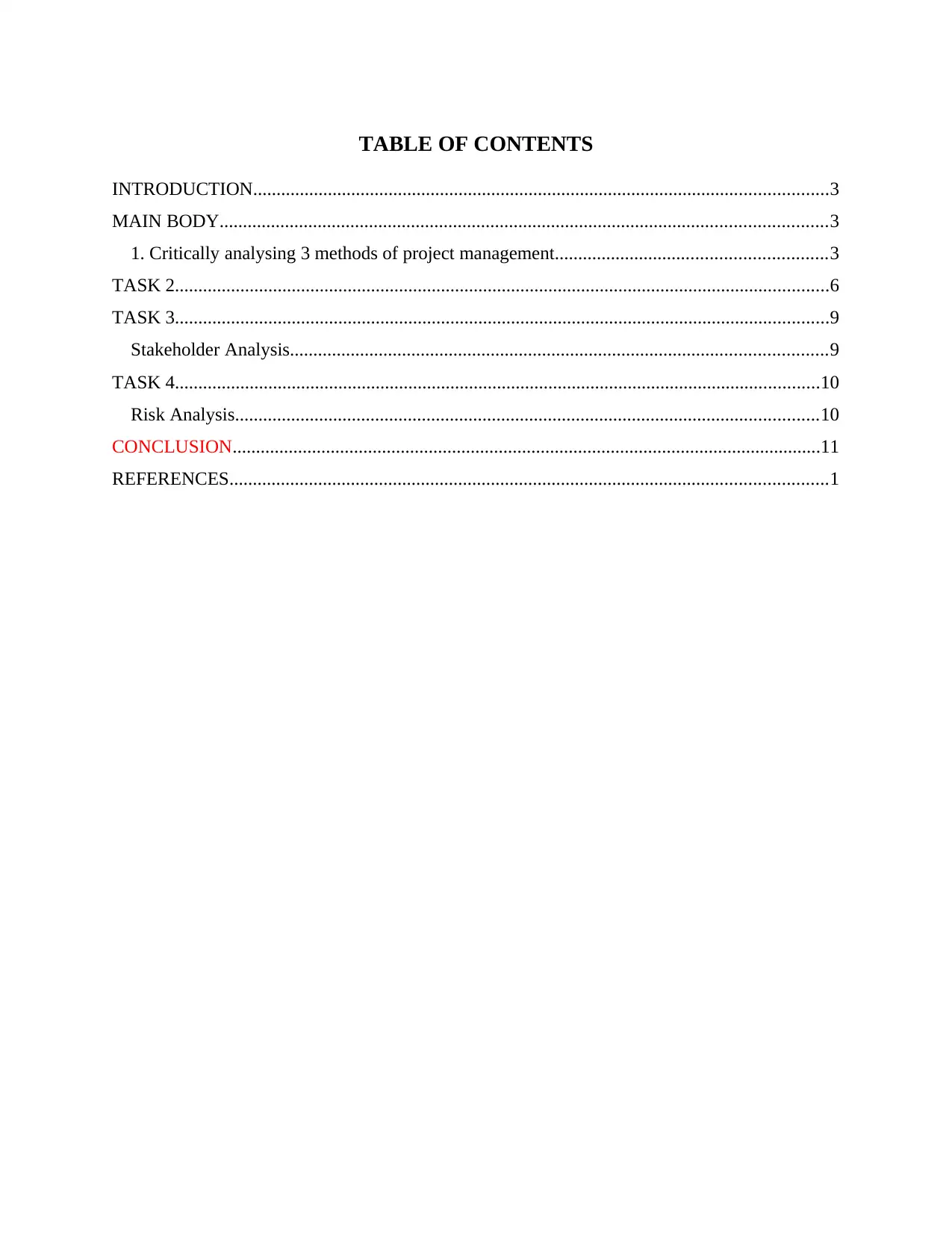
TABLE OF CONTENTS
INTRODUCTION...........................................................................................................................3
MAIN BODY..................................................................................................................................3
1. Critically analysing 3 methods of project management..........................................................3
TASK 2............................................................................................................................................6
TASK 3............................................................................................................................................9
Stakeholder Analysis...................................................................................................................9
TASK 4..........................................................................................................................................10
Risk Analysis.............................................................................................................................10
CONCLUSION..............................................................................................................................11
REFERENCES................................................................................................................................1
INTRODUCTION...........................................................................................................................3
MAIN BODY..................................................................................................................................3
1. Critically analysing 3 methods of project management..........................................................3
TASK 2............................................................................................................................................6
TASK 3............................................................................................................................................9
Stakeholder Analysis...................................................................................................................9
TASK 4..........................................................................................................................................10
Risk Analysis.............................................................................................................................10
CONCLUSION..............................................................................................................................11
REFERENCES................................................................................................................................1
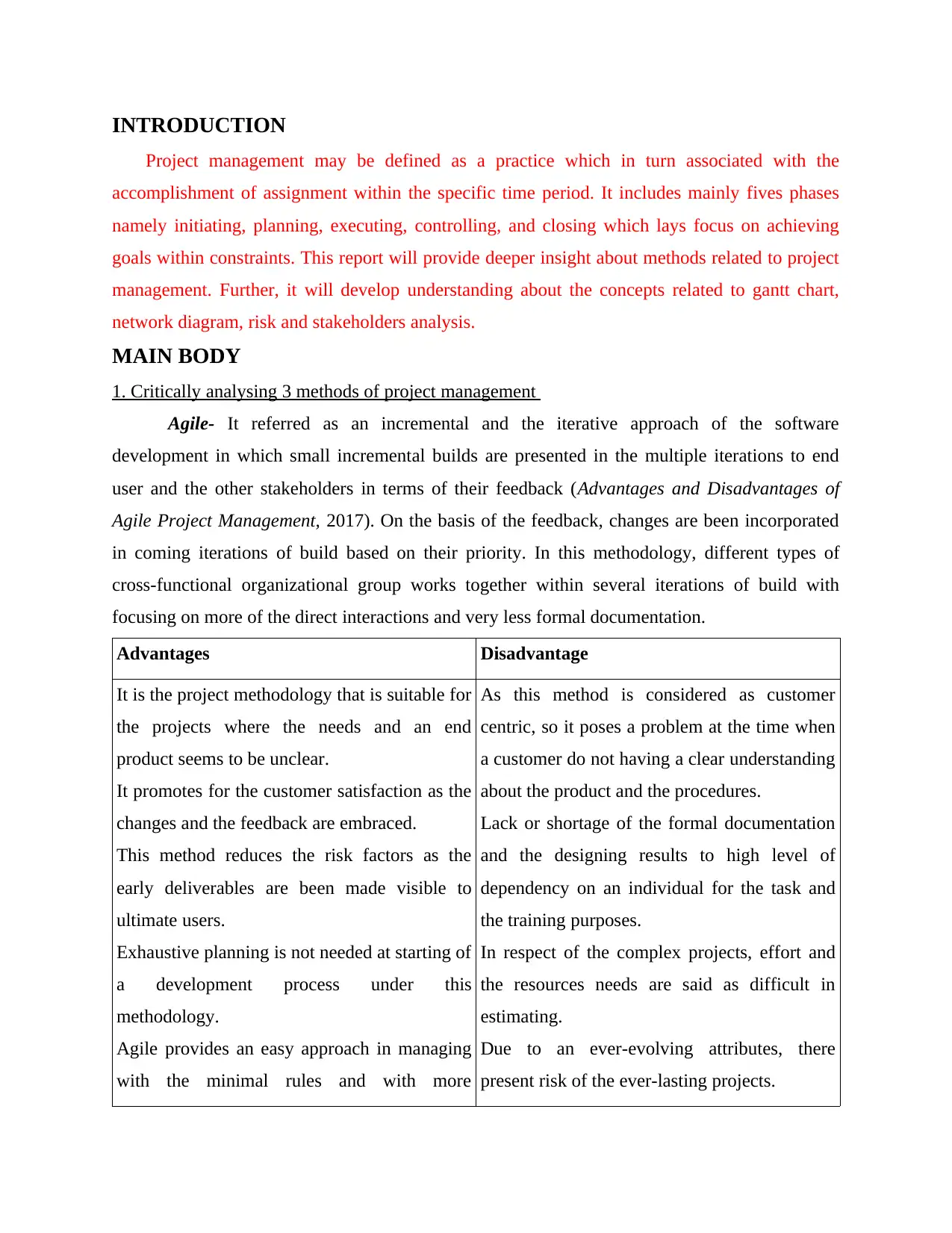
INTRODUCTION
Project management may be defined as a practice which in turn associated with the
accomplishment of assignment within the specific time period. It includes mainly fives phases
namely initiating, planning, executing, controlling, and closing which lays focus on achieving
goals within constraints. This report will provide deeper insight about methods related to project
management. Further, it will develop understanding about the concepts related to gantt chart,
network diagram, risk and stakeholders analysis.
MAIN BODY
1. Critically analysing 3 methods of project management
Agile- It referred as an incremental and the iterative approach of the software
development in which small incremental builds are presented in the multiple iterations to end
user and the other stakeholders in terms of their feedback (Advantages and Disadvantages of
Agile Project Management, 2017). On the basis of the feedback, changes are been incorporated
in coming iterations of build based on their priority. In this methodology, different types of
cross-functional organizational group works together within several iterations of build with
focusing on more of the direct interactions and very less formal documentation.
Advantages Disadvantage
It is the project methodology that is suitable for
the projects where the needs and an end
product seems to be unclear.
It promotes for the customer satisfaction as the
changes and the feedback are embraced.
This method reduces the risk factors as the
early deliverables are been made visible to
ultimate users.
Exhaustive planning is not needed at starting of
a development process under this
methodology.
Agile provides an easy approach in managing
with the minimal rules and with more
As this method is considered as customer
centric, so it poses a problem at the time when
a customer do not having a clear understanding
about the product and the procedures.
Lack or shortage of the formal documentation
and the designing results to high level of
dependency on an individual for the task and
the training purposes.
In respect of the complex projects, effort and
the resources needs are said as difficult in
estimating.
Due to an ever-evolving attributes, there
present risk of the ever-lasting projects.
Project management may be defined as a practice which in turn associated with the
accomplishment of assignment within the specific time period. It includes mainly fives phases
namely initiating, planning, executing, controlling, and closing which lays focus on achieving
goals within constraints. This report will provide deeper insight about methods related to project
management. Further, it will develop understanding about the concepts related to gantt chart,
network diagram, risk and stakeholders analysis.
MAIN BODY
1. Critically analysing 3 methods of project management
Agile- It referred as an incremental and the iterative approach of the software
development in which small incremental builds are presented in the multiple iterations to end
user and the other stakeholders in terms of their feedback (Advantages and Disadvantages of
Agile Project Management, 2017). On the basis of the feedback, changes are been incorporated
in coming iterations of build based on their priority. In this methodology, different types of
cross-functional organizational group works together within several iterations of build with
focusing on more of the direct interactions and very less formal documentation.
Advantages Disadvantage
It is the project methodology that is suitable for
the projects where the needs and an end
product seems to be unclear.
It promotes for the customer satisfaction as the
changes and the feedback are embraced.
This method reduces the risk factors as the
early deliverables are been made visible to
ultimate users.
Exhaustive planning is not needed at starting of
a development process under this
methodology.
Agile provides an easy approach in managing
with the minimal rules and with more
As this method is considered as customer
centric, so it poses a problem at the time when
a customer do not having a clear understanding
about the product and the procedures.
Lack or shortage of the formal documentation
and the designing results to high level of
dependency on an individual for the task and
the training purposes.
In respect of the complex projects, effort and
the resources needs are said as difficult in
estimating.
Due to an ever-evolving attributes, there
present risk of the ever-lasting projects.
You're viewing a preview
Unlock full access by subscribing today!
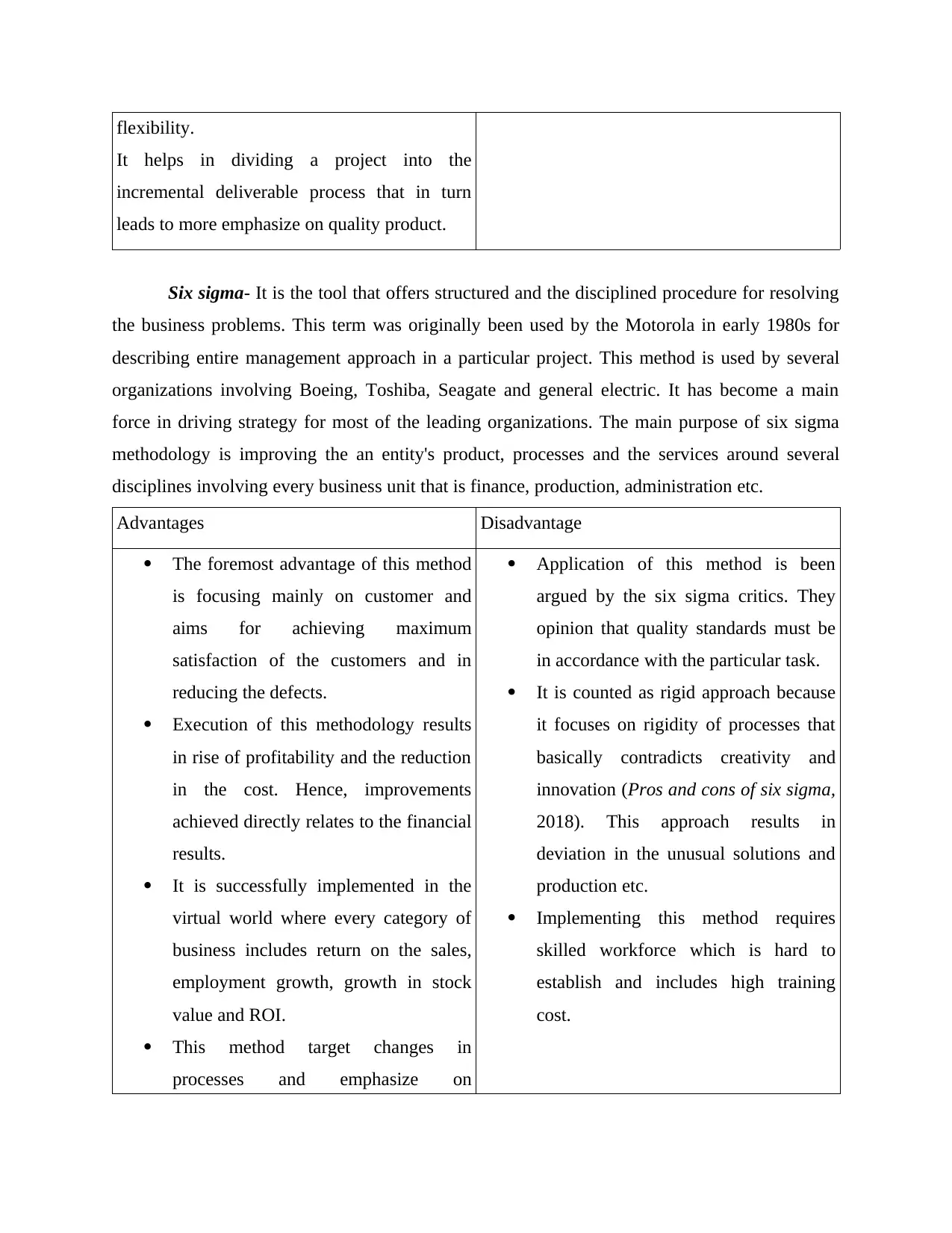
flexibility.
It helps in dividing a project into the
incremental deliverable process that in turn
leads to more emphasize on quality product.
Six sigma- It is the tool that offers structured and the disciplined procedure for resolving
the business problems. This term was originally been used by the Motorola in early 1980s for
describing entire management approach in a particular project. This method is used by several
organizations involving Boeing, Toshiba, Seagate and general electric. It has become a main
force in driving strategy for most of the leading organizations. The main purpose of six sigma
methodology is improving the an entity's product, processes and the services around several
disciplines involving every business unit that is finance, production, administration etc.
Advantages Disadvantage
The foremost advantage of this method
is focusing mainly on customer and
aims for achieving maximum
satisfaction of the customers and in
reducing the defects.
Execution of this methodology results
in rise of profitability and the reduction
in the cost. Hence, improvements
achieved directly relates to the financial
results.
It is successfully implemented in the
virtual world where every category of
business includes return on the sales,
employment growth, growth in stock
value and ROI.
This method target changes in
processes and emphasize on
Application of this method is been
argued by the six sigma critics. They
opinion that quality standards must be
in accordance with the particular task.
It is counted as rigid approach because
it focuses on rigidity of processes that
basically contradicts creativity and
innovation (Pros and cons of six sigma,
2018). This approach results in
deviation in the unusual solutions and
production etc.
Implementing this method requires
skilled workforce which is hard to
establish and includes high training
cost.
It helps in dividing a project into the
incremental deliverable process that in turn
leads to more emphasize on quality product.
Six sigma- It is the tool that offers structured and the disciplined procedure for resolving
the business problems. This term was originally been used by the Motorola in early 1980s for
describing entire management approach in a particular project. This method is used by several
organizations involving Boeing, Toshiba, Seagate and general electric. It has become a main
force in driving strategy for most of the leading organizations. The main purpose of six sigma
methodology is improving the an entity's product, processes and the services around several
disciplines involving every business unit that is finance, production, administration etc.
Advantages Disadvantage
The foremost advantage of this method
is focusing mainly on customer and
aims for achieving maximum
satisfaction of the customers and in
reducing the defects.
Execution of this methodology results
in rise of profitability and the reduction
in the cost. Hence, improvements
achieved directly relates to the financial
results.
It is successfully implemented in the
virtual world where every category of
business includes return on the sales,
employment growth, growth in stock
value and ROI.
This method target changes in
processes and emphasize on
Application of this method is been
argued by the six sigma critics. They
opinion that quality standards must be
in accordance with the particular task.
It is counted as rigid approach because
it focuses on rigidity of processes that
basically contradicts creativity and
innovation (Pros and cons of six sigma,
2018). This approach results in
deviation in the unusual solutions and
production etc.
Implementing this method requires
skilled workforce which is hard to
establish and includes high training
cost.
Paraphrase This Document
Need a fresh take? Get an instant paraphrase of this document with our AI Paraphraser
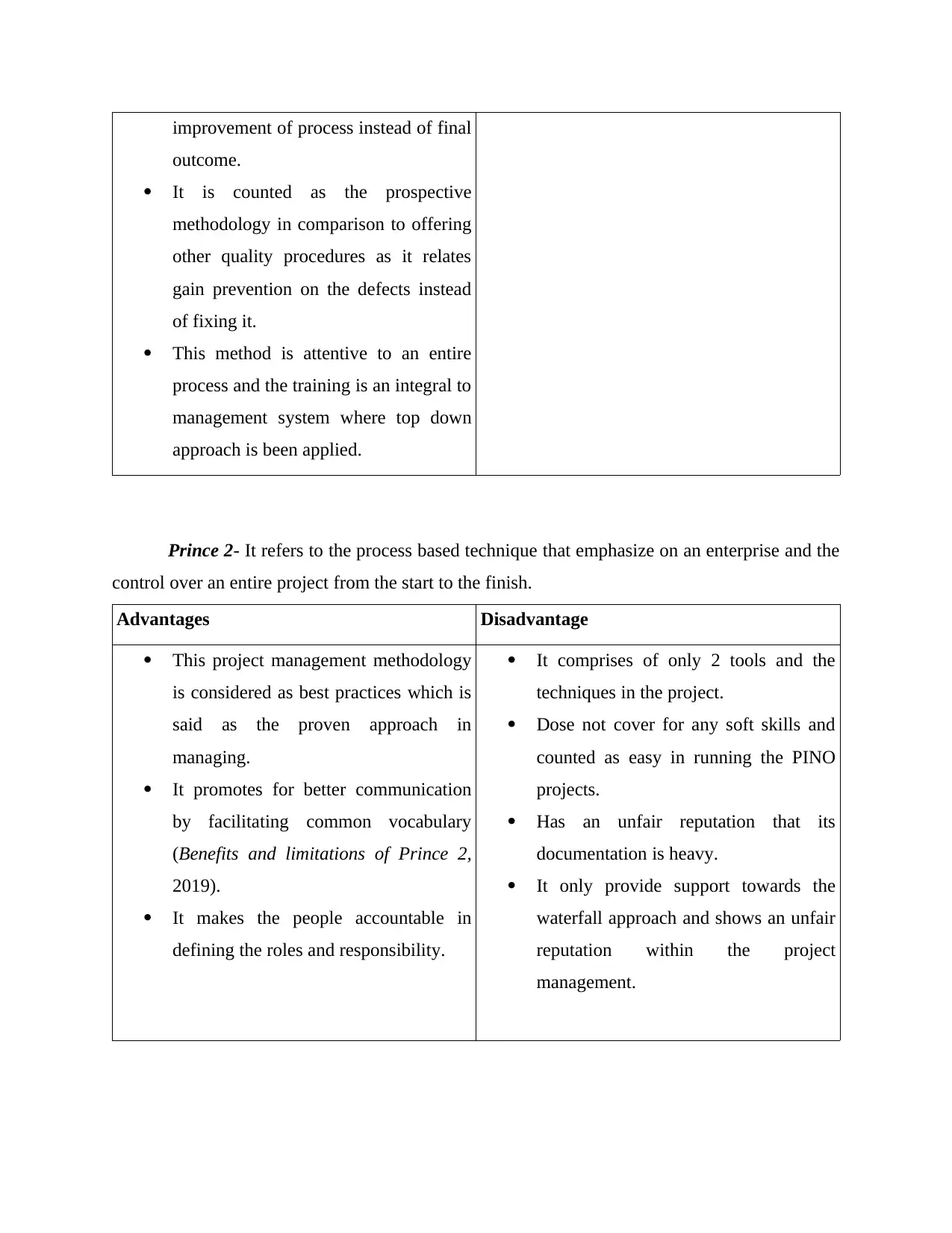
improvement of process instead of final
outcome.
It is counted as the prospective
methodology in comparison to offering
other quality procedures as it relates
gain prevention on the defects instead
of fixing it.
This method is attentive to an entire
process and the training is an integral to
management system where top down
approach is been applied.
Prince 2- It refers to the process based technique that emphasize on an enterprise and the
control over an entire project from the start to the finish.
Advantages Disadvantage
This project management methodology
is considered as best practices which is
said as the proven approach in
managing.
It promotes for better communication
by facilitating common vocabulary
(Benefits and limitations of Prince 2,
2019).
It makes the people accountable in
defining the roles and responsibility.
It comprises of only 2 tools and the
techniques in the project.
Dose not cover for any soft skills and
counted as easy in running the PINO
projects.
Has an unfair reputation that its
documentation is heavy.
It only provide support towards the
waterfall approach and shows an unfair
reputation within the project
management.
outcome.
It is counted as the prospective
methodology in comparison to offering
other quality procedures as it relates
gain prevention on the defects instead
of fixing it.
This method is attentive to an entire
process and the training is an integral to
management system where top down
approach is been applied.
Prince 2- It refers to the process based technique that emphasize on an enterprise and the
control over an entire project from the start to the finish.
Advantages Disadvantage
This project management methodology
is considered as best practices which is
said as the proven approach in
managing.
It promotes for better communication
by facilitating common vocabulary
(Benefits and limitations of Prince 2,
2019).
It makes the people accountable in
defining the roles and responsibility.
It comprises of only 2 tools and the
techniques in the project.
Dose not cover for any soft skills and
counted as easy in running the PINO
projects.
Has an unfair reputation that its
documentation is heavy.
It only provide support towards the
waterfall approach and shows an unfair
reputation within the project
management.
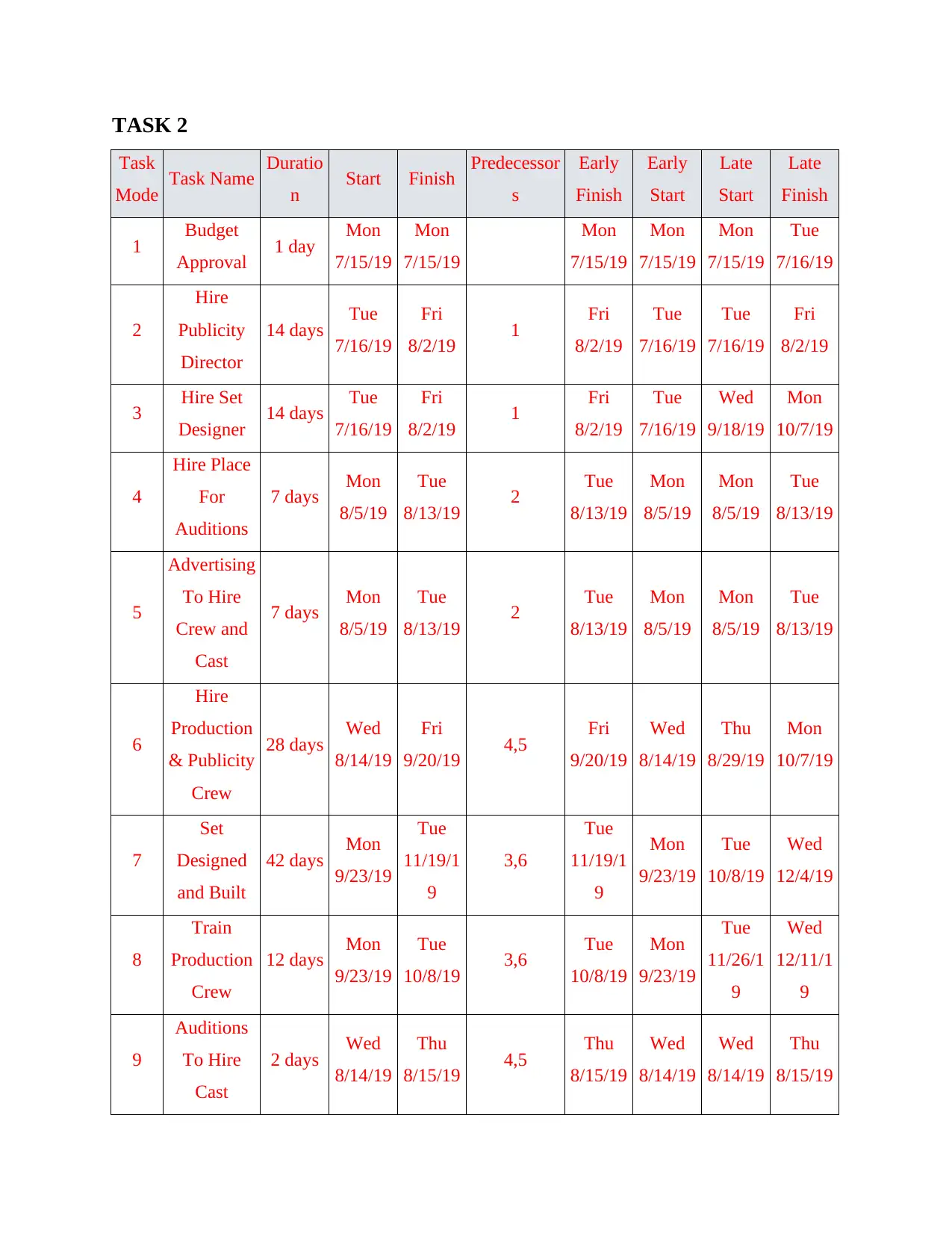
TASK 2
Task
Mode Task Name Duratio
n Start Finish Predecessor
s
Early
Finish
Early
Start
Late
Start
Late
Finish
1 Budget
Approval 1 day Mon
7/15/19
Mon
7/15/19
Mon
7/15/19
Mon
7/15/19
Mon
7/15/19
Tue
7/16/19
2
Hire
Publicity
Director
14 days Tue
7/16/19
Fri
8/2/19 1 Fri
8/2/19
Tue
7/16/19
Tue
7/16/19
Fri
8/2/19
3 Hire Set
Designer 14 days Tue
7/16/19
Fri
8/2/19 1 Fri
8/2/19
Tue
7/16/19
Wed
9/18/19
Mon
10/7/19
4
Hire Place
For
Auditions
7 days Mon
8/5/19
Tue
8/13/19 2 Tue
8/13/19
Mon
8/5/19
Mon
8/5/19
Tue
8/13/19
5
Advertising
To Hire
Crew and
Cast
7 days Mon
8/5/19
Tue
8/13/19 2 Tue
8/13/19
Mon
8/5/19
Mon
8/5/19
Tue
8/13/19
6
Hire
Production
& Publicity
Crew
28 days Wed
8/14/19
Fri
9/20/19 4,5 Fri
9/20/19
Wed
8/14/19
Thu
8/29/19
Mon
10/7/19
7
Set
Designed
and Built
42 days Mon
9/23/19
Tue
11/19/1
9
3,6
Tue
11/19/1
9
Mon
9/23/19
Tue
10/8/19
Wed
12/4/19
8
Train
Production
Crew
12 days Mon
9/23/19
Tue
10/8/19 3,6 Tue
10/8/19
Mon
9/23/19
Tue
11/26/1
9
Wed
12/11/1
9
9
Auditions
To Hire
Cast
2 days Wed
8/14/19
Thu
8/15/19 4,5 Thu
8/15/19
Wed
8/14/19
Wed
8/14/19
Thu
8/15/19
Task
Mode Task Name Duratio
n Start Finish Predecessor
s
Early
Finish
Early
Start
Late
Start
Late
Finish
1 Budget
Approval 1 day Mon
7/15/19
Mon
7/15/19
Mon
7/15/19
Mon
7/15/19
Mon
7/15/19
Tue
7/16/19
2
Hire
Publicity
Director
14 days Tue
7/16/19
Fri
8/2/19 1 Fri
8/2/19
Tue
7/16/19
Tue
7/16/19
Fri
8/2/19
3 Hire Set
Designer 14 days Tue
7/16/19
Fri
8/2/19 1 Fri
8/2/19
Tue
7/16/19
Wed
9/18/19
Mon
10/7/19
4
Hire Place
For
Auditions
7 days Mon
8/5/19
Tue
8/13/19 2 Tue
8/13/19
Mon
8/5/19
Mon
8/5/19
Tue
8/13/19
5
Advertising
To Hire
Crew and
Cast
7 days Mon
8/5/19
Tue
8/13/19 2 Tue
8/13/19
Mon
8/5/19
Mon
8/5/19
Tue
8/13/19
6
Hire
Production
& Publicity
Crew
28 days Wed
8/14/19
Fri
9/20/19 4,5 Fri
9/20/19
Wed
8/14/19
Thu
8/29/19
Mon
10/7/19
7
Set
Designed
and Built
42 days Mon
9/23/19
Tue
11/19/1
9
3,6
Tue
11/19/1
9
Mon
9/23/19
Tue
10/8/19
Wed
12/4/19
8
Train
Production
Crew
12 days Mon
9/23/19
Tue
10/8/19 3,6 Tue
10/8/19
Mon
9/23/19
Tue
11/26/1
9
Wed
12/11/1
9
9
Auditions
To Hire
Cast
2 days Wed
8/14/19
Thu
8/15/19 4,5 Thu
8/15/19
Wed
8/14/19
Wed
8/14/19
Thu
8/15/19
You're viewing a preview
Unlock full access by subscribing today!
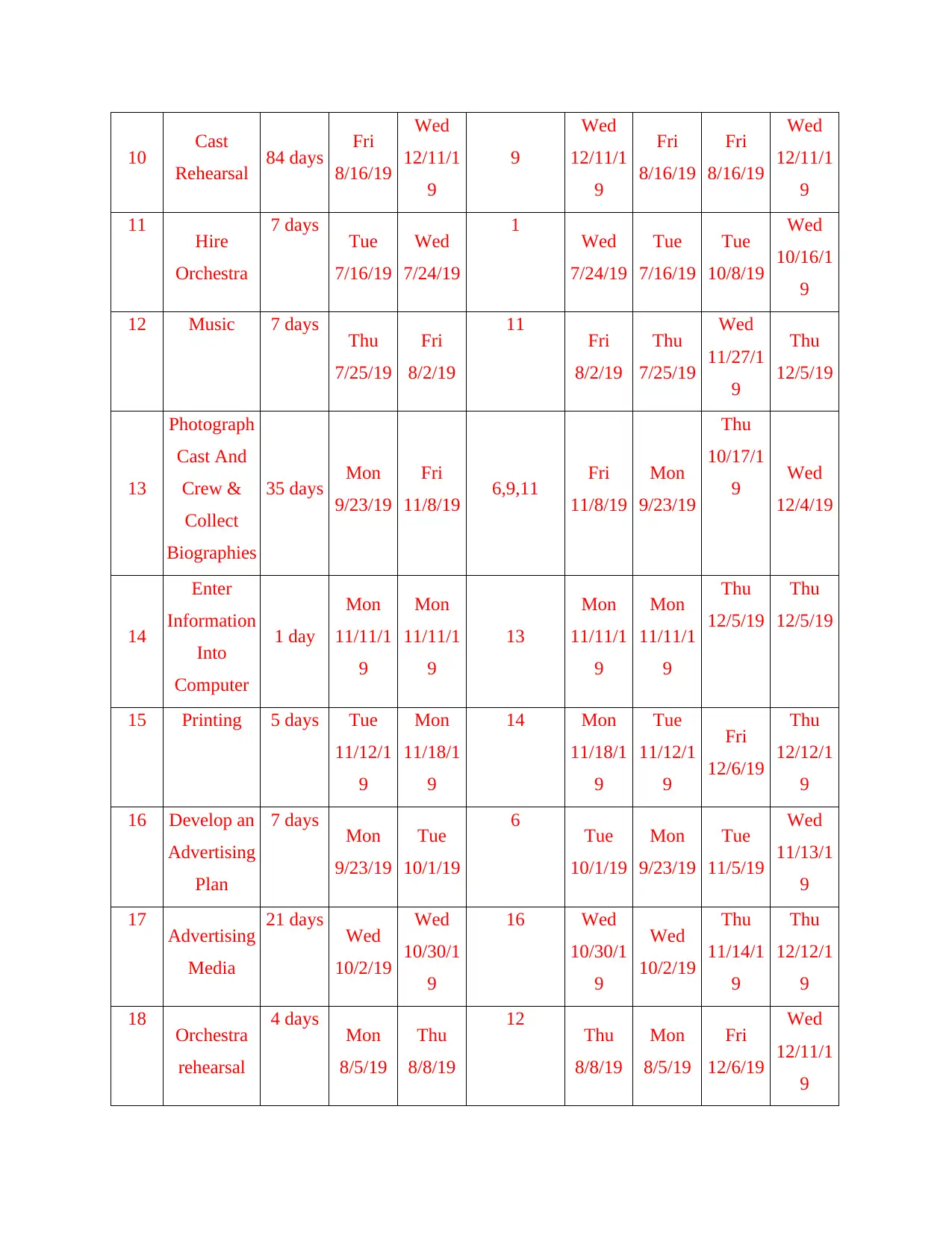
10 Cast
Rehearsal 84 days Fri
8/16/19
Wed
12/11/1
9
9
Wed
12/11/1
9
Fri
8/16/19
Fri
8/16/19
Wed
12/11/1
9
11 Hire
Orchestra
7 days Tue
7/16/19
Wed
7/24/19
1 Wed
7/24/19
Tue
7/16/19
Tue
10/8/19
Wed
10/16/1
9
12 Music 7 days Thu
7/25/19
Fri
8/2/19
11 Fri
8/2/19
Thu
7/25/19
Wed
11/27/1
9
Thu
12/5/19
13
Photograph
Cast And
Crew &
Collect
Biographies
35 days Mon
9/23/19
Fri
11/8/19 6,9,11 Fri
11/8/19
Mon
9/23/19
Thu
10/17/1
9 Wed
12/4/19
14
Enter
Information
Into
Computer
1 day
Mon
11/11/1
9
Mon
11/11/1
9
13
Mon
11/11/1
9
Mon
11/11/1
9
Thu
12/5/19
Thu
12/5/19
15 Printing 5 days Tue
11/12/1
9
Mon
11/18/1
9
14 Mon
11/18/1
9
Tue
11/12/1
9
Fri
12/6/19
Thu
12/12/1
9
16 Develop an
Advertising
Plan
7 days Mon
9/23/19
Tue
10/1/19
6 Tue
10/1/19
Mon
9/23/19
Tue
11/5/19
Wed
11/13/1
9
17 Advertising
Media
21 days Wed
10/2/19
Wed
10/30/1
9
16 Wed
10/30/1
9
Wed
10/2/19
Thu
11/14/1
9
Thu
12/12/1
9
18 Orchestra
rehearsal
4 days Mon
8/5/19
Thu
8/8/19
12 Thu
8/8/19
Mon
8/5/19
Fri
12/6/19
Wed
12/11/1
9
Rehearsal 84 days Fri
8/16/19
Wed
12/11/1
9
9
Wed
12/11/1
9
Fri
8/16/19
Fri
8/16/19
Wed
12/11/1
9
11 Hire
Orchestra
7 days Tue
7/16/19
Wed
7/24/19
1 Wed
7/24/19
Tue
7/16/19
Tue
10/8/19
Wed
10/16/1
9
12 Music 7 days Thu
7/25/19
Fri
8/2/19
11 Fri
8/2/19
Thu
7/25/19
Wed
11/27/1
9
Thu
12/5/19
13
Photograph
Cast And
Crew &
Collect
Biographies
35 days Mon
9/23/19
Fri
11/8/19 6,9,11 Fri
11/8/19
Mon
9/23/19
Thu
10/17/1
9 Wed
12/4/19
14
Enter
Information
Into
Computer
1 day
Mon
11/11/1
9
Mon
11/11/1
9
13
Mon
11/11/1
9
Mon
11/11/1
9
Thu
12/5/19
Thu
12/5/19
15 Printing 5 days Tue
11/12/1
9
Mon
11/18/1
9
14 Mon
11/18/1
9
Tue
11/12/1
9
Fri
12/6/19
Thu
12/12/1
9
16 Develop an
Advertising
Plan
7 days Mon
9/23/19
Tue
10/1/19
6 Tue
10/1/19
Mon
9/23/19
Tue
11/5/19
Wed
11/13/1
9
17 Advertising
Media
21 days Wed
10/2/19
Wed
10/30/1
9
16 Wed
10/30/1
9
Wed
10/2/19
Thu
11/14/1
9
Thu
12/12/1
9
18 Orchestra
rehearsal
4 days Mon
8/5/19
Thu
8/8/19
12 Thu
8/8/19
Mon
8/5/19
Fri
12/6/19
Wed
12/11/1
9
Paraphrase This Document
Need a fresh take? Get an instant paraphrase of this document with our AI Paraphraser
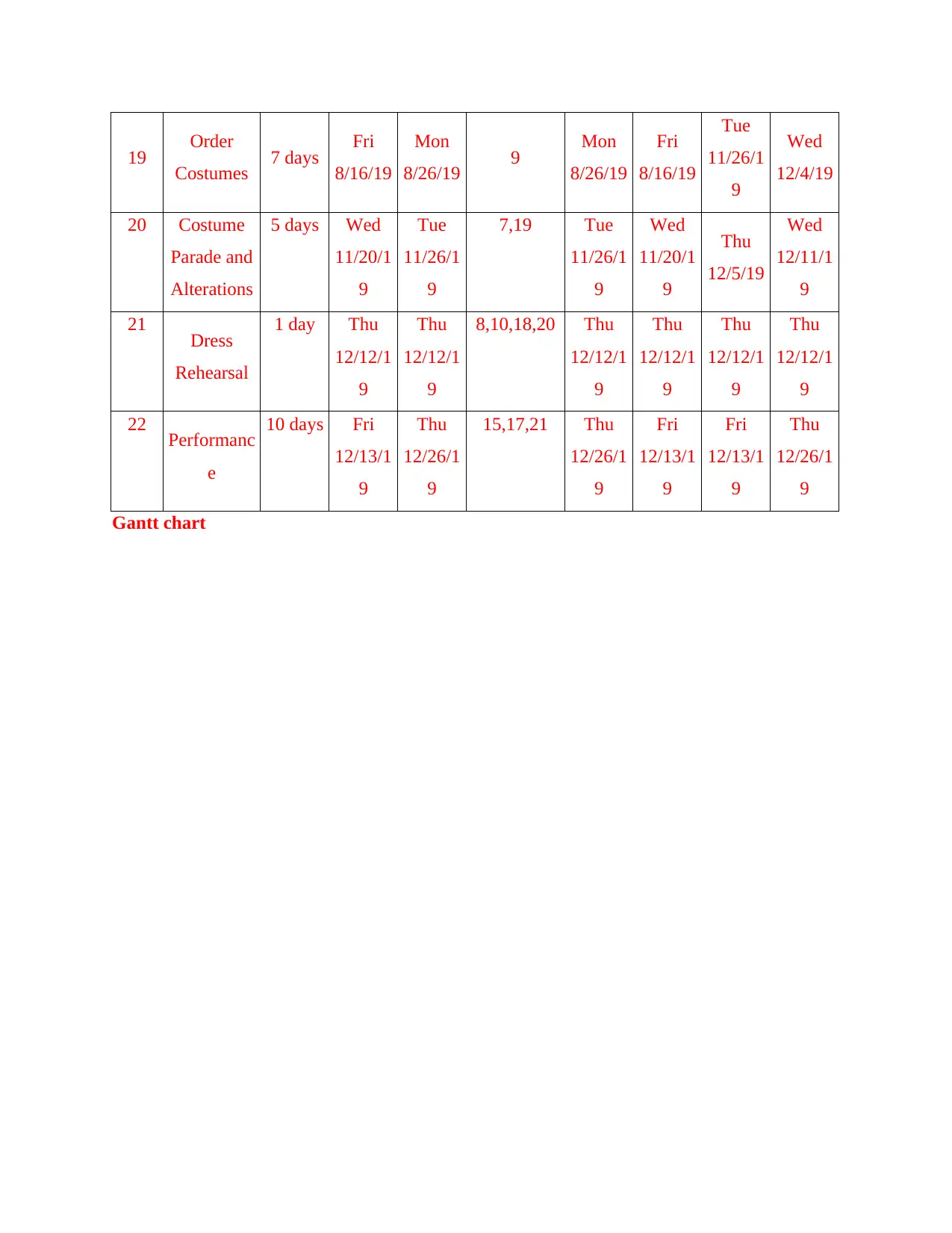
19 Order
Costumes 7 days Fri
8/16/19
Mon
8/26/19 9 Mon
8/26/19
Fri
8/16/19
Tue
11/26/1
9
Wed
12/4/19
20 Costume
Parade and
Alterations
5 days Wed
11/20/1
9
Tue
11/26/1
9
7,19 Tue
11/26/1
9
Wed
11/20/1
9
Thu
12/5/19
Wed
12/11/1
9
21 Dress
Rehearsal
1 day Thu
12/12/1
9
Thu
12/12/1
9
8,10,18,20 Thu
12/12/1
9
Thu
12/12/1
9
Thu
12/12/1
9
Thu
12/12/1
9
22 Performanc
e
10 days Fri
12/13/1
9
Thu
12/26/1
9
15,17,21 Thu
12/26/1
9
Fri
12/13/1
9
Fri
12/13/1
9
Thu
12/26/1
9
Gantt chart
Costumes 7 days Fri
8/16/19
Mon
8/26/19 9 Mon
8/26/19
Fri
8/16/19
Tue
11/26/1
9
Wed
12/4/19
20 Costume
Parade and
Alterations
5 days Wed
11/20/1
9
Tue
11/26/1
9
7,19 Tue
11/26/1
9
Wed
11/20/1
9
Thu
12/5/19
Wed
12/11/1
9
21 Dress
Rehearsal
1 day Thu
12/12/1
9
Thu
12/12/1
9
8,10,18,20 Thu
12/12/1
9
Thu
12/12/1
9
Thu
12/12/1
9
Thu
12/12/1
9
22 Performanc
e
10 days Fri
12/13/1
9
Thu
12/26/1
9
15,17,21 Thu
12/26/1
9
Fri
12/13/1
9
Fri
12/13/1
9
Thu
12/26/1
9
Gantt chart
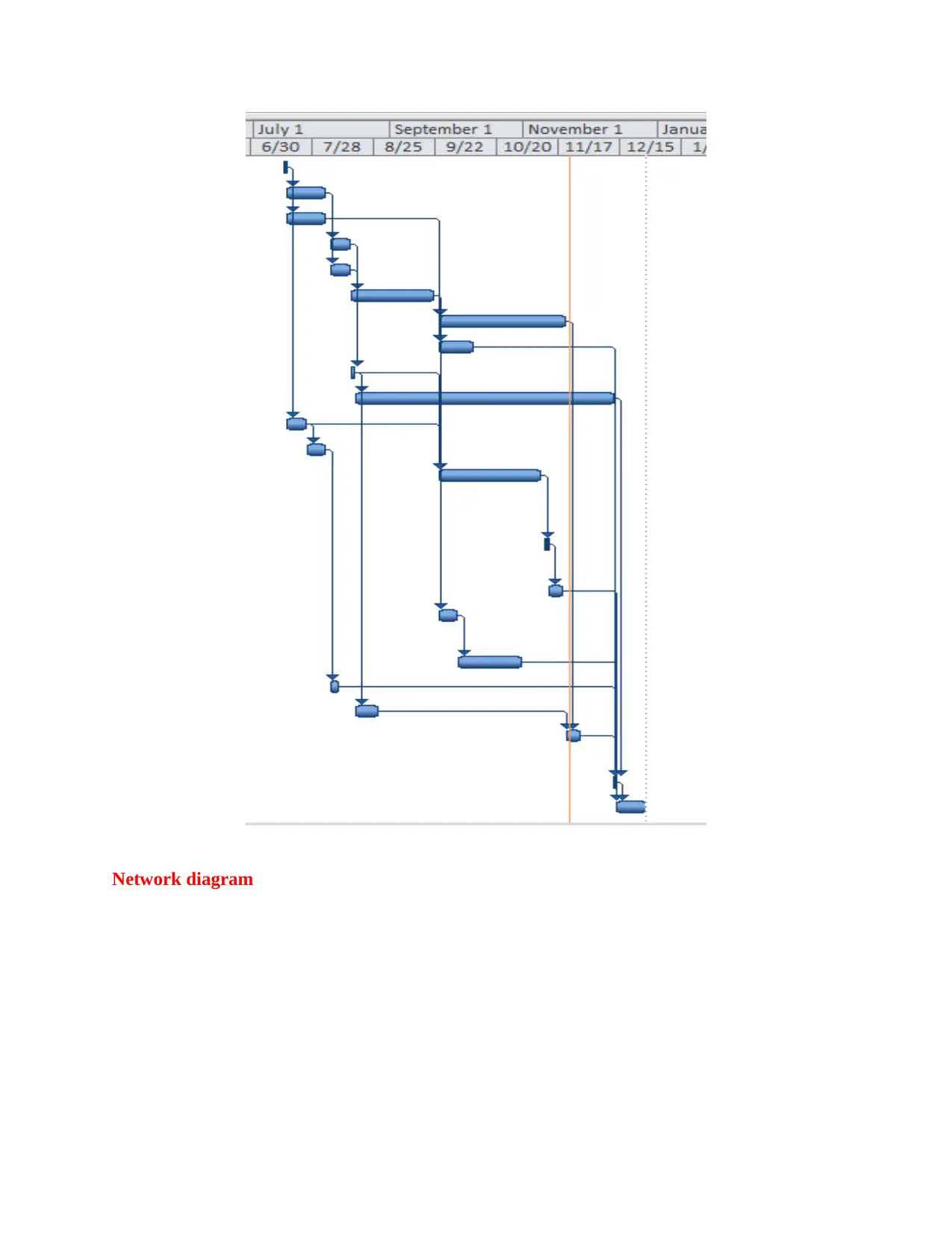
Network diagram
You're viewing a preview
Unlock full access by subscribing today!
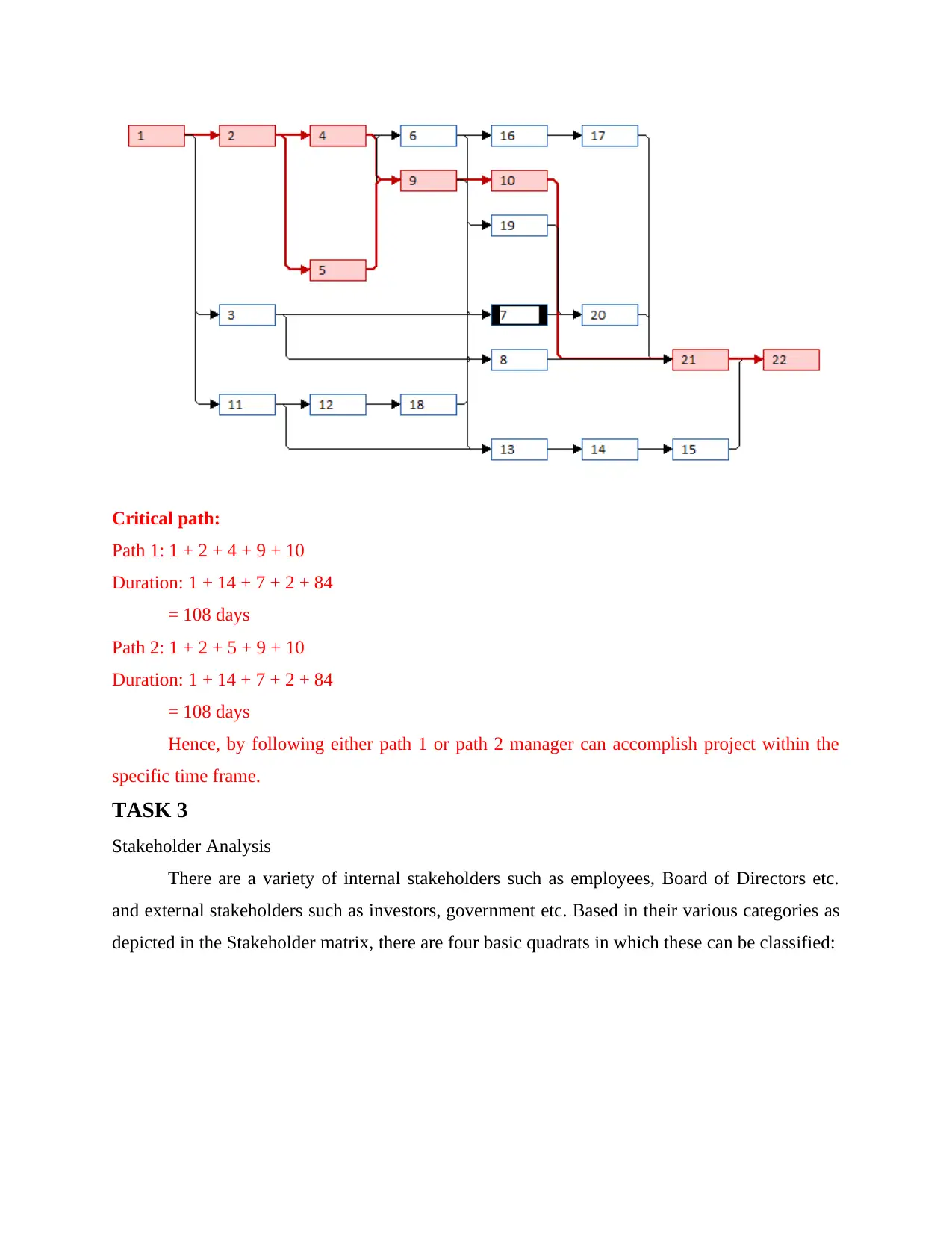
Critical path:
Path 1: 1 + 2 + 4 + 9 + 10
Duration: 1 + 14 + 7 + 2 + 84
= 108 days
Path 2: 1 + 2 + 5 + 9 + 10
Duration: 1 + 14 + 7 + 2 + 84
= 108 days
Hence, by following either path 1 or path 2 manager can accomplish project within the
specific time frame.
TASK 3
Stakeholder Analysis
There are a variety of internal stakeholders such as employees, Board of Directors etc.
and external stakeholders such as investors, government etc. Based in their various categories as
depicted in the Stakeholder matrix, there are four basic quadrats in which these can be classified:
Path 1: 1 + 2 + 4 + 9 + 10
Duration: 1 + 14 + 7 + 2 + 84
= 108 days
Path 2: 1 + 2 + 5 + 9 + 10
Duration: 1 + 14 + 7 + 2 + 84
= 108 days
Hence, by following either path 1 or path 2 manager can accomplish project within the
specific time frame.
TASK 3
Stakeholder Analysis
There are a variety of internal stakeholders such as employees, Board of Directors etc.
and external stakeholders such as investors, government etc. Based in their various categories as
depicted in the Stakeholder matrix, there are four basic quadrats in which these can be classified:
Paraphrase This Document
Need a fresh take? Get an instant paraphrase of this document with our AI Paraphraser
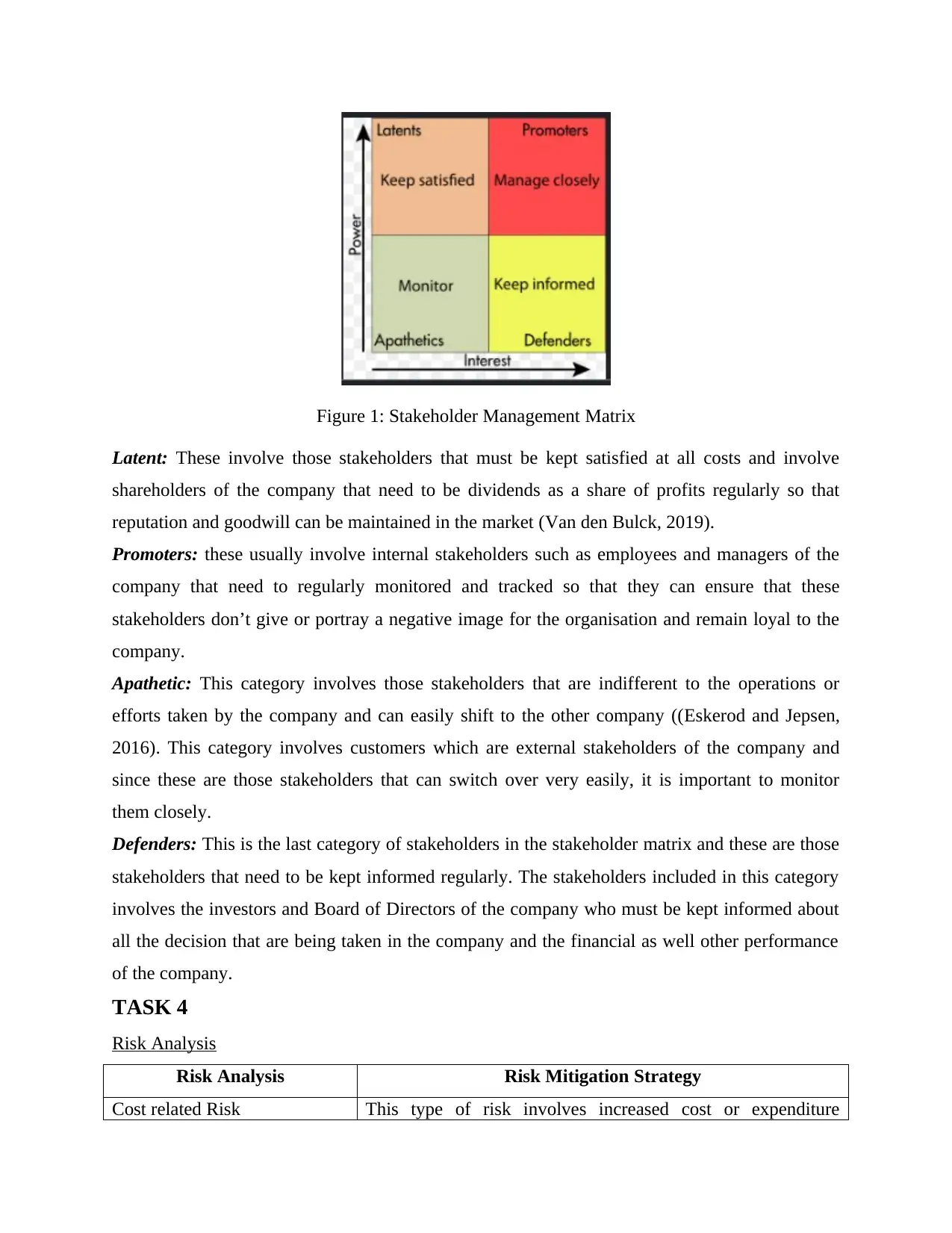
Figure 1: Stakeholder Management Matrix
Latent: These involve those stakeholders that must be kept satisfied at all costs and involve
shareholders of the company that need to be dividends as a share of profits regularly so that
reputation and goodwill can be maintained in the market (Van den Bulck, 2019).
Promoters: these usually involve internal stakeholders such as employees and managers of the
company that need to regularly monitored and tracked so that they can ensure that these
stakeholders don’t give or portray a negative image for the organisation and remain loyal to the
company.
Apathetic: This category involves those stakeholders that are indifferent to the operations or
efforts taken by the company and can easily shift to the other company ((Eskerod and Jepsen,
2016). This category involves customers which are external stakeholders of the company and
since these are those stakeholders that can switch over very easily, it is important to monitor
them closely.
Defenders: This is the last category of stakeholders in the stakeholder matrix and these are those
stakeholders that need to be kept informed regularly. The stakeholders included in this category
involves the investors and Board of Directors of the company who must be kept informed about
all the decision that are being taken in the company and the financial as well other performance
of the company.
TASK 4
Risk Analysis
Risk Analysis Risk Mitigation Strategy
Cost related Risk This type of risk involves increased cost or expenditure
Latent: These involve those stakeholders that must be kept satisfied at all costs and involve
shareholders of the company that need to be dividends as a share of profits regularly so that
reputation and goodwill can be maintained in the market (Van den Bulck, 2019).
Promoters: these usually involve internal stakeholders such as employees and managers of the
company that need to regularly monitored and tracked so that they can ensure that these
stakeholders don’t give or portray a negative image for the organisation and remain loyal to the
company.
Apathetic: This category involves those stakeholders that are indifferent to the operations or
efforts taken by the company and can easily shift to the other company ((Eskerod and Jepsen,
2016). This category involves customers which are external stakeholders of the company and
since these are those stakeholders that can switch over very easily, it is important to monitor
them closely.
Defenders: This is the last category of stakeholders in the stakeholder matrix and these are those
stakeholders that need to be kept informed regularly. The stakeholders included in this category
involves the investors and Board of Directors of the company who must be kept informed about
all the decision that are being taken in the company and the financial as well other performance
of the company.
TASK 4
Risk Analysis
Risk Analysis Risk Mitigation Strategy
Cost related Risk This type of risk involves increased cost or expenditure
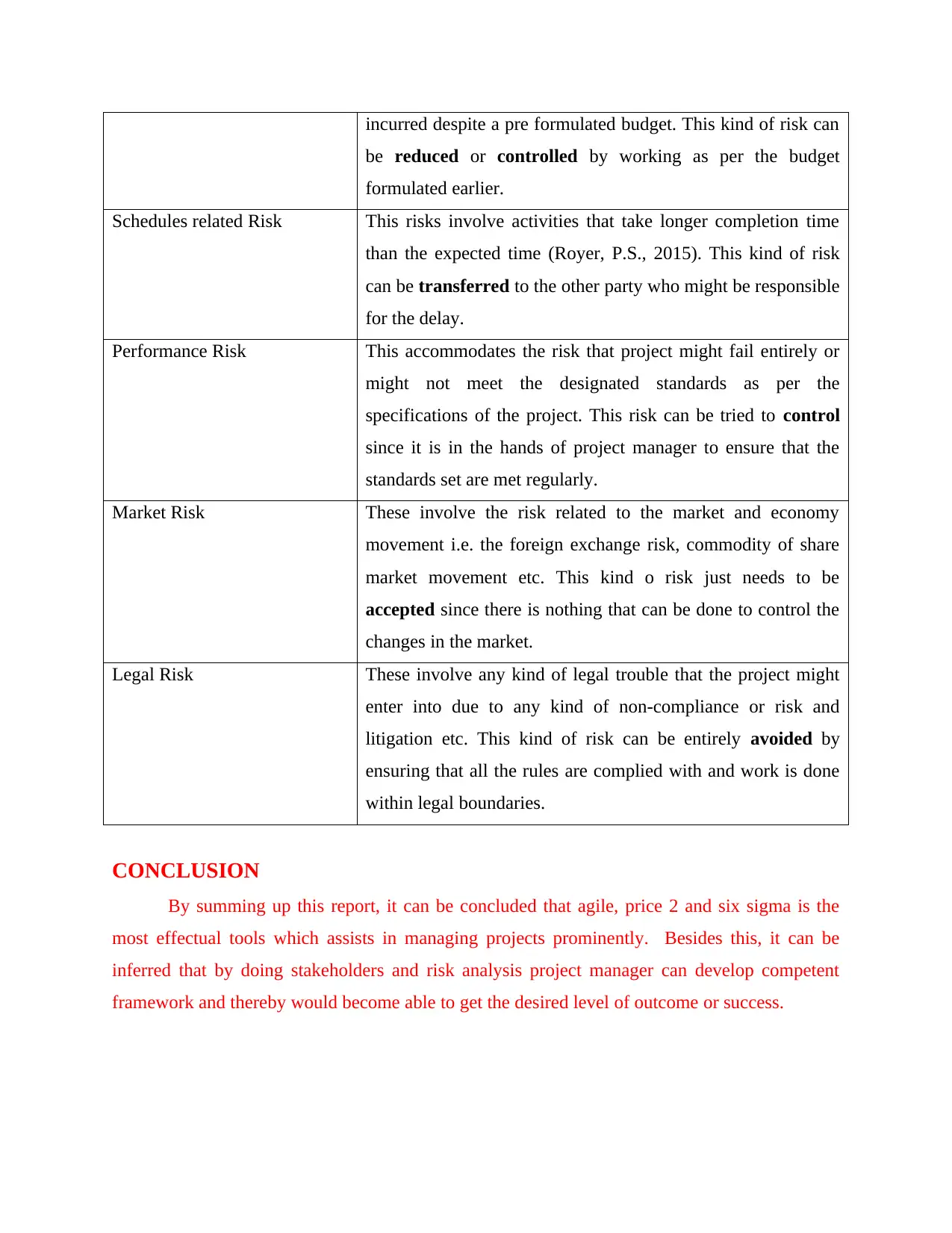
incurred despite a pre formulated budget. This kind of risk can
be reduced or controlled by working as per the budget
formulated earlier.
Schedules related Risk This risks involve activities that take longer completion time
than the expected time (Royer, P.S., 2015). This kind of risk
can be transferred to the other party who might be responsible
for the delay.
Performance Risk This accommodates the risk that project might fail entirely or
might not meet the designated standards as per the
specifications of the project. This risk can be tried to control
since it is in the hands of project manager to ensure that the
standards set are met regularly.
Market Risk These involve the risk related to the market and economy
movement i.e. the foreign exchange risk, commodity of share
market movement etc. This kind o risk just needs to be
accepted since there is nothing that can be done to control the
changes in the market.
Legal Risk These involve any kind of legal trouble that the project might
enter into due to any kind of non-compliance or risk and
litigation etc. This kind of risk can be entirely avoided by
ensuring that all the rules are complied with and work is done
within legal boundaries.
CONCLUSION
By summing up this report, it can be concluded that agile, price 2 and six sigma is the
most effectual tools which assists in managing projects prominently. Besides this, it can be
inferred that by doing stakeholders and risk analysis project manager can develop competent
framework and thereby would become able to get the desired level of outcome or success.
be reduced or controlled by working as per the budget
formulated earlier.
Schedules related Risk This risks involve activities that take longer completion time
than the expected time (Royer, P.S., 2015). This kind of risk
can be transferred to the other party who might be responsible
for the delay.
Performance Risk This accommodates the risk that project might fail entirely or
might not meet the designated standards as per the
specifications of the project. This risk can be tried to control
since it is in the hands of project manager to ensure that the
standards set are met regularly.
Market Risk These involve the risk related to the market and economy
movement i.e. the foreign exchange risk, commodity of share
market movement etc. This kind o risk just needs to be
accepted since there is nothing that can be done to control the
changes in the market.
Legal Risk These involve any kind of legal trouble that the project might
enter into due to any kind of non-compliance or risk and
litigation etc. This kind of risk can be entirely avoided by
ensuring that all the rules are complied with and work is done
within legal boundaries.
CONCLUSION
By summing up this report, it can be concluded that agile, price 2 and six sigma is the
most effectual tools which assists in managing projects prominently. Besides this, it can be
inferred that by doing stakeholders and risk analysis project manager can develop competent
framework and thereby would become able to get the desired level of outcome or success.
You're viewing a preview
Unlock full access by subscribing today!
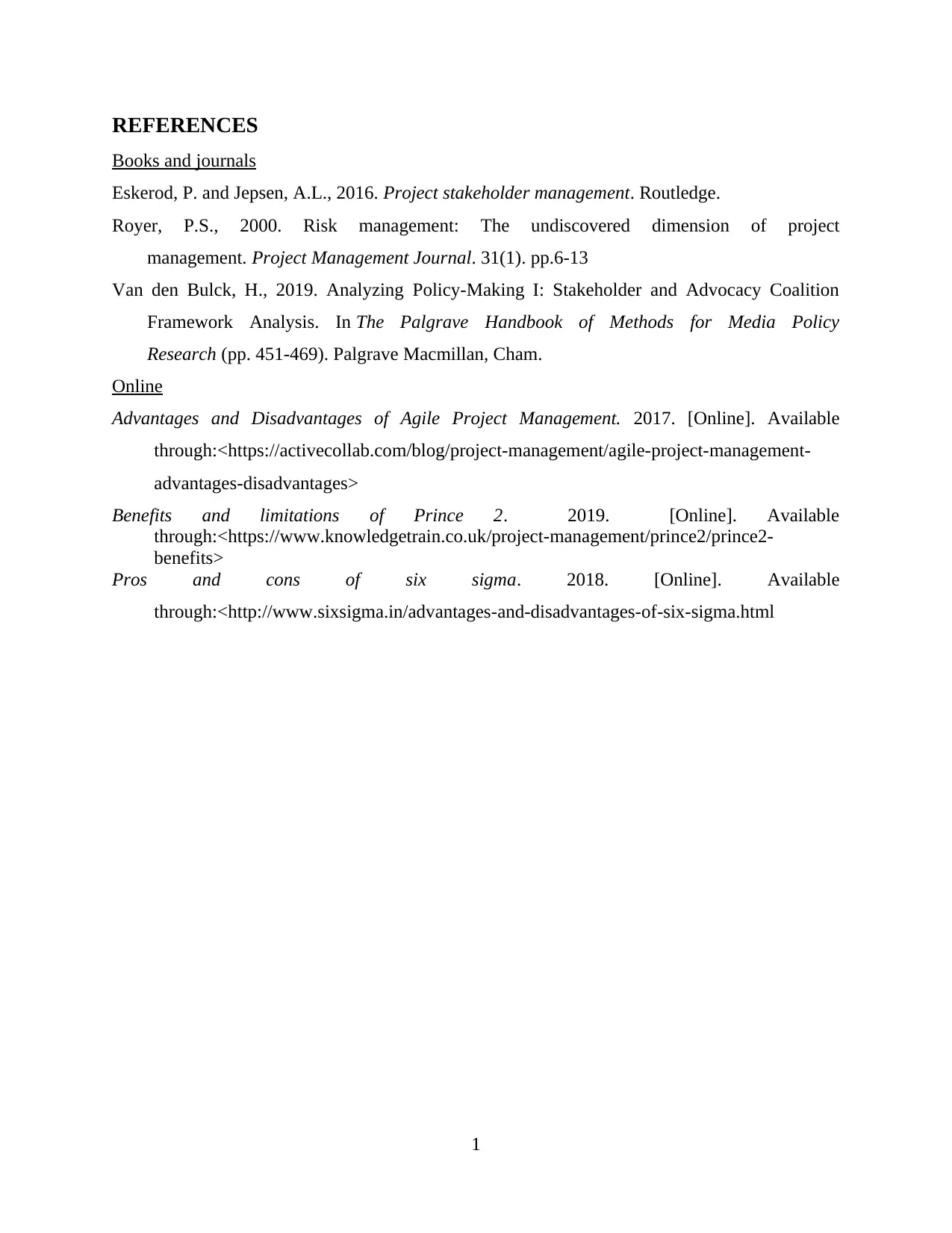
REFERENCES
Books and journals
Eskerod, P. and Jepsen, A.L., 2016. Project stakeholder management. Routledge.
Royer, P.S., 2000. Risk management: The undiscovered dimension of project
management. Project Management Journal. 31(1). pp.6-13
Van den Bulck, H., 2019. Analyzing Policy-Making I: Stakeholder and Advocacy Coalition
Framework Analysis. In The Palgrave Handbook of Methods for Media Policy
Research (pp. 451-469). Palgrave Macmillan, Cham.
Online
Advantages and Disadvantages of Agile Project Management. 2017. [Online]. Available
through:<https://activecollab.com/blog/project-management/agile-project-management-
advantages-disadvantages>
Benefits and limitations of Prince 2. 2019. [Online]. Available
through:<https://www.knowledgetrain.co.uk/project-management/prince2/prince2-
benefits>
Pros and cons of six sigma. 2018. [Online]. Available
through:<http://www.sixsigma.in/advantages-and-disadvantages-of-six-sigma.html
1
Books and journals
Eskerod, P. and Jepsen, A.L., 2016. Project stakeholder management. Routledge.
Royer, P.S., 2000. Risk management: The undiscovered dimension of project
management. Project Management Journal. 31(1). pp.6-13
Van den Bulck, H., 2019. Analyzing Policy-Making I: Stakeholder and Advocacy Coalition
Framework Analysis. In The Palgrave Handbook of Methods for Media Policy
Research (pp. 451-469). Palgrave Macmillan, Cham.
Online
Advantages and Disadvantages of Agile Project Management. 2017. [Online]. Available
through:<https://activecollab.com/blog/project-management/agile-project-management-
advantages-disadvantages>
Benefits and limitations of Prince 2. 2019. [Online]. Available
through:<https://www.knowledgetrain.co.uk/project-management/prince2/prince2-
benefits>
Pros and cons of six sigma. 2018. [Online]. Available
through:<http://www.sixsigma.in/advantages-and-disadvantages-of-six-sigma.html
1
1 out of 13
Related Documents
Your All-in-One AI-Powered Toolkit for Academic Success.
+13062052269
info@desklib.com
Available 24*7 on WhatsApp / Email
![[object Object]](/_next/static/media/star-bottom.7253800d.svg)
Unlock your academic potential
© 2024 | Zucol Services PVT LTD | All rights reserved.




